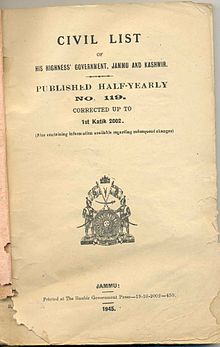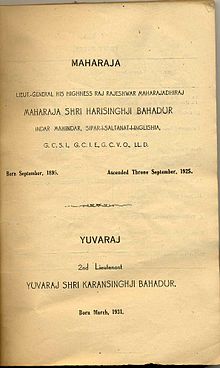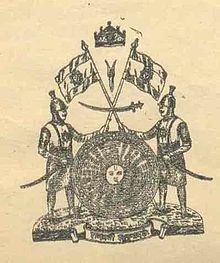- Hari Singh
-
 Maharaja of Jammu & Kashmir, Sri Hari Singh (1895-1961)
Maharaja of Jammu & Kashmir, Sri Hari Singh (1895-1961)
Maharaja Hari Singh (23 September 1895, Jammu–26 April 1961, Bombay) was the last ruling Maharaja of the princely state of Jammu and Kashmir in India.
He was married four times. With his fourth wife, Maharani Tara Devi (1910–1967), he had one son, Yuvraj (Crown Prince) Karan Singh.
Contents
Early life
Hari Singh was born on 23 September 1895 at the palace of Amar Mahal, Jammu, the only surviving son of General Raja Sir Amar Singh (14 January 1864-26 March 1909), the younger son of General Maharajadhiraj Sri Sir Ranbir Singh and the brother of Lieutenant-General Maharajadhiraj Sri Sir Pratap Singh, the then Maharaja of Jammu and Kashmir.
Education and preparation for the throne
In 1903, Hari Singh served as a Page of Honour to Lord Curzon at the grand Delhi Durbar. At the age of 13, Hari Singh was dispatched to Mayo College in Ajmer. A year later in 1909, when his father died, the British took a personal interest in his education and appointed Major H.K. Brar as his guardian. After Mayo College the ruler-in-waiting went to the Imperial Cadet Corps at Dehra Dun for military training, imbibing its British upper-crust atmosphere and polishing his English to a high gloss, and by the age of 20 he had been appointed commander-in-chief of the Jammu and Kashmir state forces.
He was a victim of blackmailing plot in Paris during his education trip to Europe.
Reign
 Title page of Civi List(List of civil officers of Hari Singh) 1945 .Interesting for two reasons. (a) Has seal of Maharaja Hari singh at Bottom.(b) On page 30 serial No:5 shows that Molvi Abdul Rahim one of the leaders of the 1931 agitation was appointed as a judge by the Maharaja in 1934.This proves that the agitation was for democratic reforms and not directed against the Maharaja
Title page of Civi List(List of civil officers of Hari Singh) 1945 .Interesting for two reasons. (a) Has seal of Maharaja Hari singh at Bottom.(b) On page 30 serial No:5 shows that Molvi Abdul Rahim one of the leaders of the 1931 agitation was appointed as a judge by the Maharaja in 1934.This proves that the agitation was for democratic reforms and not directed against the Maharaja
Following the death of his uncle, Sir Pratap Singh, in 1925, Sir Hari Singh ascended the throne of Jammu and Kashmir. He made primary education compulsory in the State, introduced laws prohibiting child marriage and threw open places of worship for the low castes.[citation needed]
Singh was hostile towards the Indian National Congress, in part because of the close friendship between Kashmiri political activist and socialist Sheikh Abdullah and Nehru. He also opposed the Muslim League and its members' communalist outlook illustrated in their two-nation theory. During the Second World War, from 1944-1946 Sir Hari Singh was a member of the Imperial War Cabinet.
In 1947, after India gained independence from British rule, Jammu and Kashmir had the option to join either India or Pakistan or to remain independent. He originally maneuvered to maintain his independence by playing off India and Pakistan. There was a widespread belief that rulers of the princely states, in deciding to accede to India or Pakistan, should respect the wishes of the population, but few rulers took any steps to consult on such decisions. Jammu and Kashmir was a Muslim majority state, and a mutiny of Muslim regiments in Gilgit followed in October 1947. Hari Singh appealed to India for help.[1] India refused to come to his aid unless he acceded to India.[2]
Hari Singh signed the Instrument of Accession on October 26, 1947, acceding the whole of his princely state (including Jammu, Kashmir, Northern Areas, Ladakh, Trans-Karakoram Tract and Aksai Chin) to the Dominion of India.[3][4] These events triggered the first Indo-Pakistan War.
After abdicating in favour of his son and heir, Hari Singh retired to Bombay (Mumbai), where he died on 26 April 1961 of a heart attack, aged 65. His son Yuvraj (Crown Prince) Karan Singh was elected 'Sadr-e-Riyasat' ('President of the Province') and Governor of the State in 1964.
Seal of Maharaja Hari Singh
Detail of the Seal of Maharaja Hari Singh as printed on the Civil List of his government is reproduced below:
The British Crown is at the top, representing Emperor of India, whose Resident was posted in Kashmir. An unidentified object[citation needed] is below the crown. Two soldiers are holding two flags. An image of the sun is between them, as the Rajput clan to which Hari Singh belonged claimed to have descended from the sun. The sword crossing the two flags may[citation needed] signify that the state was conquered by force of arms. The inscription at the bottom needs to be deciphered.[citation needed]
Family
Singh married four times in all:
- Dharampur Rani Sri Lal Kunverba Sahiba; married at Rajkot 7 May 1913, died during pregnancy in 1915. No issue.
- Chamba Rani Sahiba; married at Chamba 8 November 1915, died 31 January 1920. No issue.
- Maharani Dhanvant Kunveri Baiji Sahiba (1910-19?); married at Dharampur 30 April 1923. No issue.
- Maharani Tara Devi Sahiba of Kangra,(1910–1967); married 1928, separated 1950, one son:
- Yuvraj (Crown Prince), i.e., heir-apparent Karan Singh (9 March 1931-)
Titles
- 1895-1916: Sri Hari Singh
- 1916-1918: Raja Sri Hari Singh
- 1918-1922: Captain Raja Sri Sir Hari Singh, KCIE
- 1922-1925: Captain Raja Sri Sir Hari Singh, KCIE, KCVO
- 1925-1926: Captain His Highness Shriman Rajrajeshwar Maharajadhiraj Sri Sir Hari Singh Indar Mahindar Bahadur, Sipar-i-Sultanat, Maharaja of Jammu and Kashmir, KCIE, KCVO
- 1926-1929: Colonel His Highness Shriman Rajrajeshwar Maharajadhiraj Sri Sir Hari Singh Indar Mahindar Bahadur, Sipar-i-Sultanat, Maharaja of Jammu and Kashmir, KCIE, KCVO
- 1929-1933: Colonel His Highness Shriman Rajrajeshwar Maharajadhiraj Sri Sir Hari Singh Indar Mahindar Bahadur, Sipar-i-Sultanat, Maharaja of Jammu and Kashmir, GCIE, KCVO
- 1933-1935: Colonel His Highness Shriman Rajrajeshwar Maharajadhiraj Sri Sir Hari Singh Indar Mahindar Bahadur, Sipar-i-Sultanat, Maharaja of Jammu and Kashmir, GCSI, GCIE, KCVO
- 1935-1941: Major-General His Highness Shriman Rajrajeshwar Maharajadhiraj Sri Sir Hari Singh Indar Mahindar Bahadur, Sipar-i-Sultanat, Maharaja of Jammu and Kashmir, GCSI, GCIE, KCVO
- 1941-1946: Lieutenant-General His Highness Shriman Rajrajeshwar Maharajadhiraj Sri Sir Hari Singh Indar Mahindar Bahadur, Sipar-i-Sultanat, Maharaja of Jammu and Kashmir, GCSI, GCIE, KCVO.
- 1946-1961: Lieutenant-General His Highness Shriman Rajrajeshwar Maharajadhiraj Sri Sir Hari Singh Indar Mahindar Bahadur, Sipar-i-Sultanat, Maharaja of Jammu and Kashmir, GCSI, GCIE, GCVO
Honours
- Delhi Durbar Medal-1903
- Delhi Durbar Medal-1911
- Prince of Wales Visit Medal-1922
- Knight Grand Commander of the Order of the Indian Empire (GCIE)-1929 (KCIE-1918)
- Grand Cross of the Order of the Crown of Italy-1930
- Knight Grand Commander of the Order of the Star of India (GCSI)-1933
- King George V Silver Jubilee Medal-1935
- King George VI Coronation Medal-1937
- Hon. LL.D from Punjab University-1938
- Grand Officer of the Legion d'Honneur-1938
- 1939-1945 Star-1945
- Africa Star-1945
- War Medal 1939-1945-1945
- India Service Medal-1945
- Knight Grand Cross of the Royal Victorian Order (GCVO)-1946 (KCVO-1922)
- Indian Independence Medal-1947
See also
- List of topics on the land and the people of “Jammu and Kashmir”
- The royal house of Jammu and Kashmir
- Hari Singh Blackmail case
References
- ^ Maharaja Hari Singh's Letter to Mountbatten
- ^ Jammu and Kashmir: A Backgrounder[dead link]
- ^ Justice A. S. Anand, The Constitution of Jammu & Kashmir (5th edition, 2006), page 67
- ^ Kashmir, Research Paper 04/28 by Paul Bowers, House of Commons Library, United Kingdom., page 46, 2004-03-30
External links
- Genealogy of the ruling chiefs of Jammu and Kashmir
- Proclamation of May 1, 1951 on Jammu & Kashmir Constituent Assembly by Yuvraj (Crown Prince) Karan Singh (Son of Maharajah Hari Singh) from the Official website of Government of Jammu and Kashmir, India
- Conflict in Kashmir: Selected Internet Resources by the Library, University of California, Berkeley, USA; University of California at Berkeley Library Bibliographies and Web-Bibliographies list
- [Ref.: http://newstodaynet.com/2006sud/06jan/1201ss1.htm The role of Shri Guruji Golwalkar (Sir Sanghachalak of the Rashtreeya Swayamsevak Sangh - R S S)]
Hari SinghBorn: 23 September 1895 Died: 26 April 1961Regnal titles Preceded by
Pratap Singh
(as Maharaja of Jammu and Kashmir)Maharaja of Jammu and Kashmir
1925-1949Succeeded by
Monarchy abolished 1949; succeeded by Republic of IndiaTitles in pretence Preceded by
None— TITULAR —
Maharaja of Jammu and Kashmir
1949-1961
Reason for succession failure:
Monarchy abolished in 1949Succeeded by
Karan SinghCategories:- Indian politicians
- Knights Grand Commander of the Order of the Star of India
- Knights Grand Commander of the Order of the Indian Empire
- Knights Grand Cross of the Royal Victorian Order
- 1895 births
- 1961 deaths
- Maharajas of Jammu and Kashmir
- Indian Hindus
- Kashmiri people
Wikimedia Foundation. 2010.


